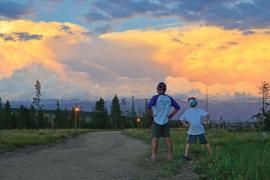Wow. One hundred and fifty years of organized camping! What an amazing milestone! I don't think that it's too much of a stretch that simply having survived one hundred and fifty years is testament to the intrinsic worth of the programs, opportunities, and growth that is the camp experience. What an ideal opportunity, then, for us to look at some of the facilities that have supported the mainstays of camp over that century and a half.
Hey! Let's eat! Ravenous youngsters long predate camping. But the swarming hordes of starving campers full of fresh air after high energy activities probably stunned the first food service managers. Given the primitive roots of camping, they probably managed pretty well in large tents where one might feed a well-supplied army. The permanent dining hall became a camp fixture as soon as it appeared that this camping thing was really going to catch on. In my consulting practice, I've been very fortunate to have visited one of these early log structures, and it remains incredibly functional in that capacity. For the sake of our discussion, let's call it "Chuckwagon Hall."
Still, there have been literally dozens of roadblocks which have made keeping Chuckwagon functional very difficult. First, folks have had to come to grips with the idea that in 1880, nobody was thinking "flex space," or "multipurpose." They needed sheltered space where they could reliably feed the masses. Moreover, camping was a summer-only activity. Over time, there have been multiple attempts at making it "yearround," with most of them falling well short of their modern counterpart. Most often, that comes about because working around old stuff makes providing things like heat and electricity that much more difficult. It's easy to imagine, then, why retrofit costs substantially more than an identical installation in a building of modern construction. Where costs rule the project (and I've not been on a project where that wasn't the case!), the installation has to be pared back to match funds available.
What about windows in Chuckwagon Hall? There were no such things as screens when the building went up, and glass panes were expensive and hard to come by. Square window openings were more of a convenient mistake than the result of good planning. Finally, anyone who has worked with whole-log buildings will tell you that the logs settle and compress over time. Although it's a slow process, it's absolutely measurable. Doors, windows (again), and modern requirements like range hoods and fire suppression systems aren't the fixed elements that we expect them to be — like they are in modern structures. My point is this: While old structures at camp may be nostalgic, they also have limitations. Although they may look similar to something constructed recently (because primitive is pretty "in" right now), their construction may be fundamentally different from modern techniques. When the "sky's the limit" in the budget, those differences may not be a problem. When money is limited, though, there are similar limits to the performance and modifications that an old building can support.
And after we eat and drink . . . . If you're a regular reader of "Building Principles," you should have known that we'd get to wastewater treatment somewhere in this column. And here we are! We've looked at a range of systems through the years, from pit privies (July/August 2008, "Don't Linger Too Long in the Outhouse") to centralized treatment plants (March/April and May/June 2004, "Drama in Real Life," a twopart series). These facilities in particular seem to have been installed over time with the overriding design criteria of using whatever is least expensive, easiest, and fastest to install. Surprisingly, these seem also to have been some of the most long-lived facilities, since many, many camps have no idea where their systems are, where their pipes run, when they were built, or even how they work. In-ground systems in particular chug along year after year, and nobody really thinks about them until they malfunction by spewing onto the ground. Suddenly then, it's a fire drill of epic proportions. In a very scary sense, that drama and excitement is reserved for the lucky folks. The unlucky ones have their systems fail beneath the ground by leaching undertreated wastewater into the groundwater, and find out there is a problem only after people get sick (September/October 2007, "The Sky is Falling!").
One great aspect of this facility is that although these systems still aren't cheap by any means, technology for onsite wastewater treatment and disposal has enabled sites to support camps where they couldn't have functioned safely before. Over the last century, volumes of research on the subject has been conducted and then adapted to the real world, which has helped renovate wastewater to neardrinkable levels. Now, everyone's rivers, streams, and wells benefit by receiving this highly cleansed, nearly ready to reuse discharge. The advancing technology, though, comes at a cost to camps. Now that such treatment can be accomplished, environmental regulators increasingly seek to require that all discharges meet those very high standards. In this case, camp doesn't bring these changes on itself, like it might when renovating the dining hall. Instead, it comes about when a permit is renewed, or when the older facilities begin to break down and need to be repaired or replaced. Concentrating hundreds of people in a relatively small area suddenly has a very real, very definite cost and impact on the operations. Just as the saying goes, "You only want a drink when the well runs dry," most people never think about the toilet until they can't flush. So what can be done?
There are actually lots of ways to prepare before there's a crisis. For one, find and have a surveyor map all of the systems on camp. Don't know where they are? There are ways to find that buried stuff without digging it up. Your local sanitarian, engineer, or septic installer may be the best person to help you there. Next and probably not as obvious, install water meters at representative buildings, and record both the water usage and the daily occupancy of those facilities. These two small bits of information are priceless when you need to replace or repair a system. That's because you'll know 1) Where the old one is (to put the new one in a new place), and 2) How big to make it to serve camp's flow volumes. With all of that at your fingertips, you'll be a hero to your health department, your designer, and your comptroller.
What about the camps that have a centralized wastewater treatment plant instead of a dozen septic systems? How can they get ahead of the curve and avoid being behind the classic eight ball? For starters, the two preceding suggestions still hold. Knowing where your pipes are buried will go a long way toward knowing how to add to the system. Documented water usage at specific facilities will help you size new plant components, or determine whether you have groundwater seeping into the buried pipes, as opposed to water escaping your pressurized water supply system. Old gravity collection pipe systems can be very leaky, in some cases more than doubling the discharge flow of the plant by taking on ground water. How great would it be to discover that you didn't really need to double the size of the plant, but instead reline the gravity pipes and manholes to exclude groundwater? One other thing that you can do is to become attuned to the environmental regulatory climate either directly or through your consultant and plant operator. They should be aware of changes that are "in the wind" and could eventually trickle down to your operation. By anticipating and planning for those sorts of changes, you can prepare the facility and the capital budget long before there's a crisis.
What about the ol' hitching post? For the uninitiated, a hitching post was a fixture to which a rider would tie his or her horse so it wouldn't wander off. I'd imagine that an awful lot of readers probably knew that, but few have seen a real hitching post in use. That's because most people aren't riding their horse to camp. Nope. They're driving every different type of vehicle imaginable, and instead of hitching their horses, they're parking cars. The good news is that most cars won't wander away, once you walk away from them. That said, though, parked cars take up much more room than parked horses (do you "park" horses?), and require a much more refined surface on which to travel safely and effectively. A lousy parking area may just be part of the benefit package for the staff, but if guests to your facility have to park in a pasture better suited for horses, that's a problem! We shared some ideas associated with accessing and designing parking areas before (November/December 2009, "On Paving Paradise"), but did anyone really take the time to look and see what could be done to improve the situation? With vehicle sales trying to trend toward electric and hybrid-type vehicles, vehicle suspensions are changing. To the camp, that means that visitors' vehicles may be less able to tolerate a rough ride. So what was good enough for decades past may now be so uninviting that guests don't return. If, however, your ultimate plan is for them to never leave, then maybe you don't want to address that. That's certainly your call either way.
Though my kids enjoy giving me a hard time about getting older, I like to think that I'm getting wiser with the experience that comes with age. With that in mind, though, I know that I can't do all of the things that I once could, and the wisdom of age seems to be helping me make those decisions pretty well. So while I continue to hike and hunt and fish, playing full contact football is out of the question. The same mindset holds true for all of your experienced facilities. With ongoing attention, time, and effort, your infrastructure should continue to serve you well. Don't make the mistake of confusing "experience" with "ability" by forgetting what those facilities were originally intended to do, or how many they were intended to serve.
Rick Stryker is a professional engineer with a particular passion for helping camps with infrastructure, planning, and regulatory issues. He can always be reached at [email protected] or (570) 828-4004.


